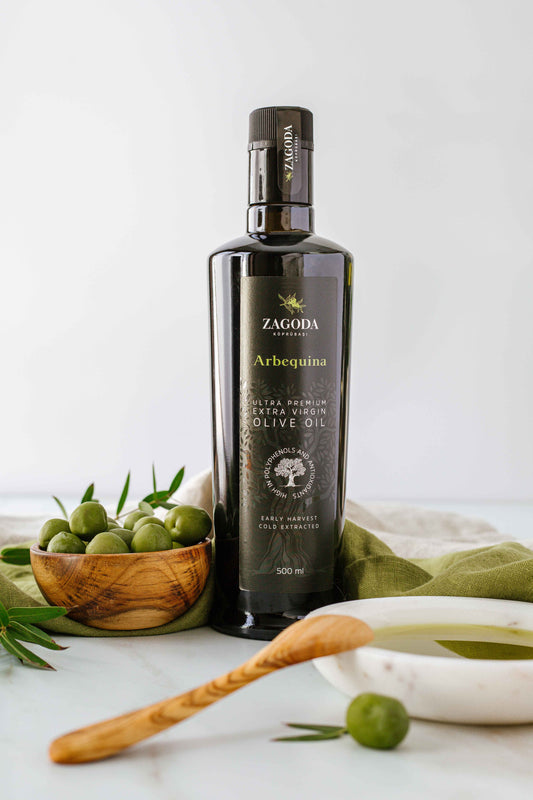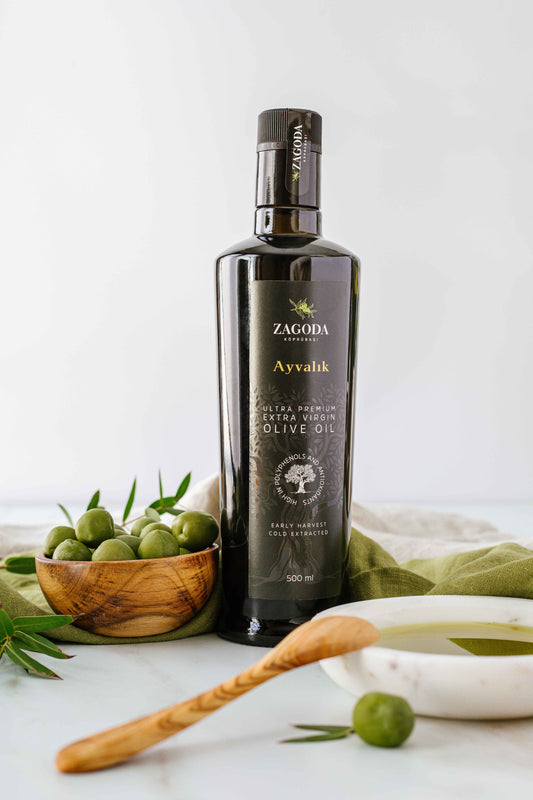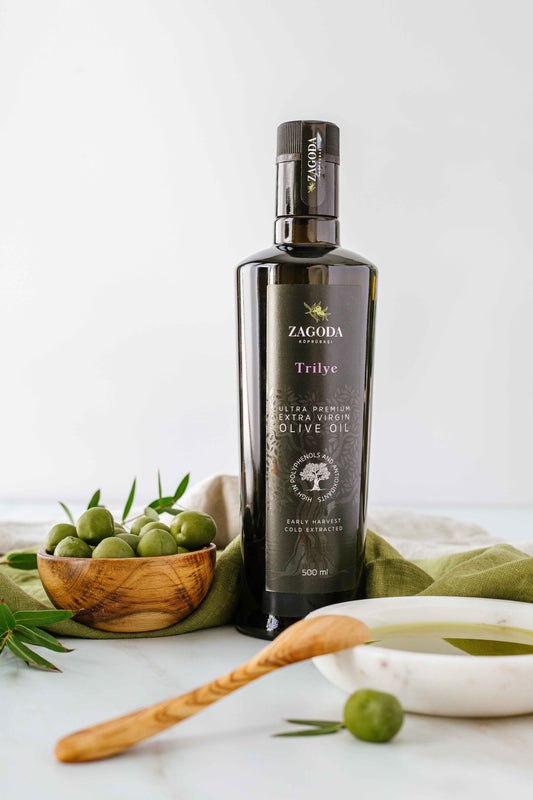Do you try olive oil ice cream? Homemade rich and creamy ice cream is created using extra virgin olive oil as it is sometimes called. Remarkably well, olive oil's sharp, fruity, and nutty notes blend into a sweet application like this. To believe it, you must taste it!
This recipe deserves to be shared even though I'm not usually one to enjoy weird ice cream tastes. Although olive oil is typically used in savory recipes, avoid putting it off just yet it can also be used to make incredibly smooth handmade ice cream with an aroma that is both solid and delicate.
Find the finest extra virgin olive oil for your recipe. Purchase premium extra virgin olive Now!
How to make olive oil ice cream?
Let's analyze this ice cream recipe using pictures that show each step:
Recipe Ingredients
-
Half-and-half, or a blend of heavy cream and whole milk
-
extract from vanilla
-
yolks of eggs
-
White sugar in granules
-
Extra virgin olive oil (a fruity, fresh variety; further details below)
Step 1: In a large bowl, whisk together the sugar and eggs
Place the yolks, sugar, and salt in a bowl and let the half-and-half warm up in a saucepan. A pleasing flavor balance is always achieved by including a small amount of salt in sweet recipes.
For about 30 seconds, vigorously mix the ingredients until they become thick and creamy. Lifting the whisk out of the bowl will cause the mixture to slowly drip down and form a ribbon-like structure.
Step 2: Stir the slicing cream
We call this process tempering. Tempering is the process of gradually increasing the temperature of eggs without disturbing the components.
Step 3: Cook on low heat until the base of the ice cream thickens
Re-fill the saucepan with all the ingredients and set it on low or medium-low heat. For a few minutes, stir continuously in a figure-8 motion until the mixture coats the spoon or spatula's back. When is it sufficiently thick? How can you tell? With your finger, you ought to be able to draw a line through it.
To ensure the eggs are cooked through without risk, check the mixture's temperature with a digital thermometer by making sure it reaches 165 degrees.
Step 4: Chill the mixture in a bowl with a plastic wrap pressed up against the surface
Pour the blend into a sanitized basin. To avoid skin from forming on top as it cools, cover the mixture with plastic wrap, pressing the plastic directly against the liquid and whisking until the mixture is smooth. Put in the fridge and let it cool for about four hours.
Step 5: Spin Ice Cream
To continue making the ice cream, place the chilled ice cream into your ice cream maker and proceed according to the manufacturer's directions.
Choice of Olive Oil:
For this dish, a pricey olive oil is not necessary. But while selecting an oil I would pay particular attention to these qualities:
- Choose a fruity olive oil instead of a green, peppery one.
- Use a mild olive oil (however if you don't mind a stronger flavor, you can use a stronger oil).
- Use FRESH olive oil that has been bought recently within a few months.
- When we made this dish for the first time, we used my regular olive oil, which I knew was fresh because we always buy new bottles. I was not fond of the flavor of dull olive oil aftertaste, so I decided to look for something fruitier.
Where did olive oil on ice cream come from?
Olive oil has long been used in sweets in the olive-growing regions of Spain and Italy. People who have enjoyed traditional delicacies like EVOO cake and brought the idea back with them have spread the notion around the world. Chef Nancy Silverton described how using olive oil in cakes and gelato was a complete surprise to her in a 2013 LA Times article.
And she didn't simply mean to use it as a garnish. Olive oil works just as well as a basic ingredient in gelato, its fruity, slightly bitter aromas contrasting nicely with the sugar and milk's creamy richness.
Research conducted by Raffaele Sacchi, an agri-food industries professor at the University of Naples Federico II, demonstrates that extra virgin olive oil can be used to substitute fat in gelato, favorably altering the ratio of saturated to unsaturated fat. Additionally, Sacchi clarified that olive oil-based ice cream has "pleasant floral, herbaceous notes" (Olive Oil Times).
If all of this conversation about the contrast between oil and ice cream piques your interest, you may go even further down this rabbit hole by adding chili crisp oil on top of vanilla ice cream. Foodies are not simply those looking for culinary tricks like combining chocolate pudding with ramen noodles.
Explore the different types of Olive oil ice cream
1. Arbequina
The well-known ice cream manufacturer Salt & Straw has tested and proven this solution. To accentuate the buttery qualities found in its well-liked ice cream, its olive oil ice cream flavor recipe includes grassy arbequina olive oil. Arbequina is recognized for its fruity, herbal, and somewhat sweet flavor. This particular cultivar can be harvested sooner than others; it is primarily found in California and Spain.
This gives it a mild flavor character that works well as a topping for creamy ice cream or as a complement to a variety of produce and proteins. A 500-milliliter bottle of arbequina can be purchased for a reasonable price from Zagoda Olive Oil.
2. Picual
Although Spain has more than 200 varieties of olives, picual, which yields a fruity olive oil variety, is the most often grown. Due to its naturally high oil content, this olive produces a lot of oil for consumer goods. Tasters are going to find hints of almond, pepper, and olive leaf in this oil, which makes it the ideal slightly bitter partner for any ice cream flavor, from fruity to chocolate.
Pour this over pistachio ice cream for a delightfully velvety and nutty taste. You may elevate your dish by covering your olive oil-crowned ice cream with chopped almonds or crumbled cookies. These crunchy toppings, the creamy ice cream, and the silky oil will create a beautiful textural opposition to your dessert.
3. Hojiblanca
Hojiga is another type of olive oil from Spain that works well for sprinkling over desserts. Its fruity backbone is similar to that of its brother, picual. But this oil is also characterized by peppery undertones that are supported by vegetal and grassy aromas, as well as an almond aftertaste.
Hojiblanca oil, which translates to "white leaf" in Spanish, is an excellent option for counterbalancing sweet flavors because of its moderate sweetness and medium bitterness. It pairs particularly well with any fruity ice cream flavor. To bring out the almond flavors in the hojiblanca, sprinkle toasted nuts over the top of your bowl.
Conclusion
In conclusion, making olive oil ice cream is a delightful way to enjoy a unique and creamy dessert. The recipe is simple and brings out the rich, fruity flavor of the olive oil, which pairs perfectly with the sweetness of the ice cream. Whether you're an adventurous foodie or just looking to try something new, olive oil ice cream is sure to impress. Give it a try and enjoy a taste that's both sophisticated and surprisingly delicious.





